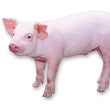Assoc.Prof Le Van Tho – Technical advisor of BIO-PHARMACHEMIE
Until Febuary 26th 2013, PRRS outbreaks which hadn’t passed 21-day period with thousands of pigs died and destroyed occurred in Quang Nam, Long An, Quang Tri and Bac Lieu, causing huge economic losses for stockpeople. We would like to introduce to farmers how to recognize, treat and prevent effectively with this dangerous syndromes.
Until Febuary 26th 2013, PRRS outbreaks which hadn’t passed 21-day period with thousands of pigs died and destroyed occurred in Quang Nam, Long An, Quang Tri and Bac Lieu, causing huge economic losses for stockpeople. We would like to introduce to farmers how to recognize, treat and prevent effectively with this dangerous syndromes.
- ROUTE OF TRANSMISSION
Porcine reproductive and respiratory syndrome (PRRS), also known as blue-ear disease, only infects pigs of all ages. Virus is present in air, saliva, nasal mucus, feces and urine and transmitted via transport of infected pigs or pork from one place to another. Pathogens can be transmitted via oral route (food, water), air-borne, venereal, injecting equipments, farming tools, transporting vehicles etc.
After the virus enters the body to respiratory organs, they will destroy macrophages to weaken body defense system, causing immunodeficiency in order to multi-infect and worsen the host condition. In addition, the virus also enters genital tract of the boars, the reproductive organs of the sows, causing stillbirth and premature delivery. The reason causing death in high number of pigs is secondary infection, in which the most dangerous infection are swine fever virus and some bacteria that cause haemorrhagic septicemia, salmonellosis, typhoid fever, etc.
After the virus enters the body to respiratory organs, they will destroy macrophages to weaken body defense system, causing immunodeficiency in order to multi-infect and worsen the host condition. In addition, the virus also enters genital tract of the boars, the reproductive organs of the sows, causing stillbirth and premature delivery. The reason causing death in high number of pigs is secondary infection, in which the most dangerous infection are swine fever virus and some bacteria that cause haemorrhagic septicemia, salmonellosis, typhoid fever, etc.
- HOW TO RECOGNIZE PRRS
- GENERAL INFORMATION
- PRRS occurs in many different stages of age in the same farm.
- Swine fever over 400C, anorexia, cough and dyspnea.
- Reddening of the skin, sometimes with bruises, blisters, purple /blue discolouring of the ears and tail. Piglets were suffered from splay-legs, trembling, diarrhea and high mortality rate.
Three important features for accurate diagnosis:
- SOWS AND BOARS
- Signs are stillbirth, mummification, abortion in PRRS pregnant sows.
- Premature delivery: sows farrow a few days sooner than normal (before 110 days).
- Weak piglets, high death rate of new-born piglets.
- Agalactia and mastitis after birth (these are specific clinical signs).
- Pseudo-oestrus or slow returning to estrus after birth.
- Decreased libido and semen quality in boars
- SKIN MANIFESTATION
To differentiate clinical signs between PRRS and other red skin diseases, PRRS infected pigs usually show skin reddening (subcutaneous congestion) or red blisters on the body, purple/blue discolouring of the ears, nose, legs and apex of tail. Sometimes there are epistaxis and umbilicus haemorrhage in piglets. Those are specific lesions of PRRS.
.JPG) |
- CLINICAL SIGNS ON RESPIRATORY SYSTEM
PRRS virus attacks the respiratory system causing pneumonia, cough, abnormal breath and dyspnea in pigs. If PRRS is followed by secondary infections on respiratory tract (Staphylococcus, Mycoplasma, APP, etc.), pneumonia will be worsen.
“If there are signs mentioned above present in your pig farms, it is possible that PRRS have presented at your farm.”
“If there are signs mentioned above present in your pig farms, it is possible that PRRS have presented at your farm.”
- TREATMENT
There is no specific medication for PRRS, but in reality, PRRS can be prevented or deteriorated by performing full vaccination including PRRS, Classical swine fever, Salmonella, Pasteurella, Mycoplasma. Feeding adequate nutrition, ensuring hygiene level in housing system and disinfecting farm regularly. For PRRS infected pigs, stockpeople should take the following steps:
- First, reduce fever for swine: use one of the following drugs, BIO-ANAZINE, BIO-ANAZIN.C. In addition, add electrolytes as BIO-ELECTROLYTES or BIO VITA-ELECTROLYTES.
- Then use antibiotics: use one of the following drugs which are highly effective with secondary infection by PRRS as BIO-TULACIN 100, dose: 1ml/40kg body weight, IM at the neck with a single dose; BIO-CEFQUIN dose: 1ml/12,5kg body weight, IM one time per day repeat next 5 days; or , BIO-CEVIT, BIO-VITAMIN C 10%. Vitamin supplement as BIO-VIT PLUS , In cases of pigs that experience anaphylactic shock after PRRS vaccination, do not utilize antibiotics but medicate with antipyretics, booster medicine, well feeding and keep the pens warm.
- In peace:
- When weather changes, add one of the following drugs into the feed to control bacteria that infect respiratory tract and digestive tract: BIO-TYLODOX PLUS, BIO-COLIDOX, BIO-CEFACOL, BIO AMCOLI-PLUS, BIO-AMPI+ERY. Then use BIO-VITAMIN C 10% or BIO SOL ADE-C, BIO-VITASOL to boost immunity.
- In outbreaks:
- Immediately isolate the infected pigs to treat individually.
- Do not slaughter sick pigs at home, do not throw the carcasses into the river or the field, must bury deeply and sprinkle lime powder.
- Do not hide epidemic disease.
- Do not buy sick pigs and pork.
- During the epidemic season, should restrict new pigs to the herd (need to isolate at least 3 weeks for monitoring).
- Limit visitors.
- Spray disinfectant 2 times per week with BIO-GUARD, BIOSEPT, BIODINE ®, BIOXIDE.
- For consumers

 Hotline:
Hotline:

.jpg?width=120&height=90&mode=pad&anchor=auto&scale=both)









Comments